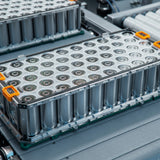Graphene Materials
Graphene has been in the research spotlight since its discovery in 2004. It has excellent mechanical, electrical, chemical, optical, and thermal properties with great specific surface area.
Like diamond, graphene is pure carbon. It is defined as a two-dimensional single layer of carbon atoms bonded together in a hexagonal honeycomb lattice structure. Each carbon atom is bonded to three adjacent carbon atoms through a σ bond. Graphene is flexible, strong, and lightweight. With a sheet thickness of 0.34 nm, it is the thinnest and strongest nanomaterial, estimated to be 200 times stronger than steel.
Graphene oxide (GO) involves rich active oxygen-containing functional groups, such as epoxide, carbonyl, carboxyl, and hydroxyl groups. Reduced graphene oxide (rGO) contains residual oxygen and other heteroatoms, as well as structural defects.
We have a great collection of graphene materials including graphene oxide, graphite, doped graphene powder, graphene carbon nanotubes composites, and graphene sheets and films.
Browse Graphene Materials
Related categories: low dimensional materials, 2D materials
Filter by form:
Resources and Support
 What is Graphene Oxide?
What is Graphene Oxide?
Graphene oxide (GO) is a two-dimensional material with oxygen-functionalized surfaces, derived from graphite.
Read more... What is Graphene?
What is Graphene?
Graphene is a hexagonal lattice of carbon atoms that connect to form a single sheet in 2 dimensions.
Read more... Graphene vs Graphite
Graphene vs Graphite
Graphene is a single layer of carbon atoms arranged in a hexagonal pattern, like a sheet of paper. Graphite, on the other hand, is made up of many layers of graphene stacked on top of each other, like a stack of paper.
Read more... Safely Reducing Graphene Oxide
Safely Reducing Graphene Oxide
The conversion of graphene oxide back to graphene is therefore of huge interest to both the scientific and industrial community.
Read more... Graphene Properties and Applications
Graphene Properties and Applications
Graphene materials have ultrahigh surface area, high strength, and exceptional conductivity making them highly valuable for various applications. Its large surface area enhances energy storage, sensor sensitivity, and water purification efficiency.
Read more... Carbon Nanotubes vs Graphene: Structure, Properties and Uses
Carbon Nanotubes vs Graphene: Structure, Properties and Uses
Carbon nanotubes (CNTs) and graphene are two ground-breaking nanomaterials composed entirely of carbon atoms. Both are allotropes of carbon where atoms are bonded in a hexagonal lattice.
Learn more... Graphene Batteries
Graphene Batteries
Graphene batteries are advanced energy storage devices. Graphene materials are two-dimensional and are typically made solely of carbon.
Read more... Graphene Battery vs Lithium-Ion Battery
Graphene Battery vs Lithium-Ion Battery
This page discusses the pros and cons of Lithium-ion (Li-ion) batteries and graphene batteries and the future outlook for battery research.
Learn more...








